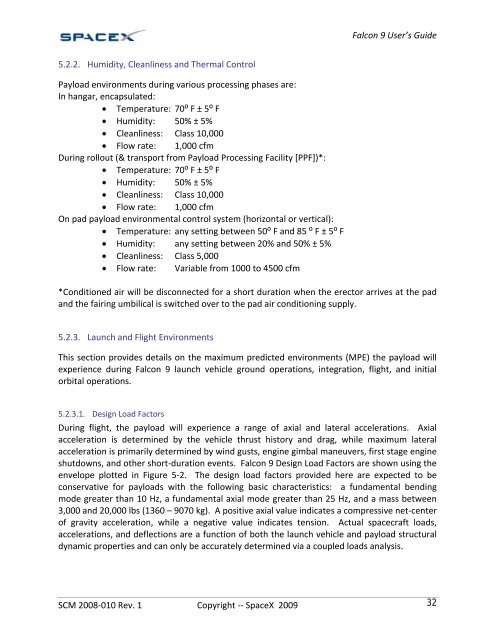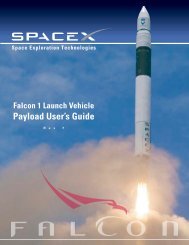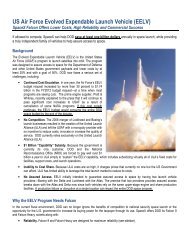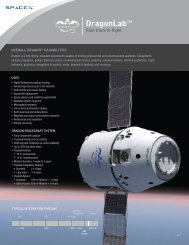Falcon 9 Launch Vehicle Payload User's Guide - SpaceX
Falcon 9 Launch Vehicle Payload User's Guide - SpaceX
Falcon 9 Launch Vehicle Payload User's Guide - SpaceX
Create successful ePaper yourself
Turn your PDF publications into a flip-book with our unique Google optimized e-Paper software.
5.2.2. Humidity, Cleanliness and Thermal Control<br />
<strong>Payload</strong> environments during various processing phases are:<br />
In hangar, encapsulated:<br />
• Temperature: 70⁰ F ± 5⁰ F<br />
• Humidity: 50% ± 5%<br />
• Cleanliness: Class 10,000<br />
• Flow rate: 1,000 cfm<br />
During rollout (& transport from <strong>Payload</strong> Processing Facility [PPF])*:<br />
• Temperature: 70⁰ F ± 5⁰ F<br />
• Humidity: 50% ± 5%<br />
• Cleanliness: Class 10,000<br />
• Flow rate: 1,000 cfm<br />
On pad payload environmental control system (horizontal or vertical):<br />
• Temperature: any setting between 50⁰ F and 85 ⁰ F ± 5⁰ F<br />
• Humidity: any setting between 20% and 50% ± 5%<br />
• Cleanliness: Class 5,000<br />
• Flow rate: Variable from 1000 to 4500 cfm<br />
<strong>Falcon</strong> 9 User’s <strong>Guide</strong><br />
*Conditioned air will be disconnected for a short duration when the erector arrives at the pad<br />
and the fairing umbilical is switched over to the pad air conditioning supply.<br />
5.2.3. <strong>Launch</strong> and Flight Environments<br />
This section provides details on the maximum predicted environments (MPE) the payload will<br />
experience during <strong>Falcon</strong> 9 launch vehicle ground operations, integration, flight, and initial<br />
orbital operations.<br />
5.2.3.1. Design Load Factors<br />
During flight, the payload will experience a range of axial and lateral accelerations. Axial<br />
acceleration is determined by the vehicle thrust history and drag, while maximum lateral<br />
acceleration is primarily determined by wind gusts, engine gimbal maneuvers, first stage engine<br />
shutdowns, and other short‐duration events. <strong>Falcon</strong> 9 Design Load Factors are shown using the<br />
envelope plotted in Figure 5‐2. The design load factors provided here are expected to be<br />
conservative for payloads with the following basic characteristics: a fundamental bending<br />
mode greater than 10 Hz, a fundamental axial mode greater than 25 Hz, and a mass between<br />
3,000 and 20,000 lbs (1360 – 9070 kg). A positive axial value indicates a compressive net‐center<br />
of gravity acceleration, while a negative value indicates tension. Actual spacecraft loads,<br />
accelerations, and deflections are a function of both the launch vehicle and payload structural<br />
dynamic properties and can only be accurately determined via a coupled loads analysis.<br />
SCM 2008‐010 Rev. 1 Copyright ‐‐ <strong>SpaceX</strong> 2009 32





